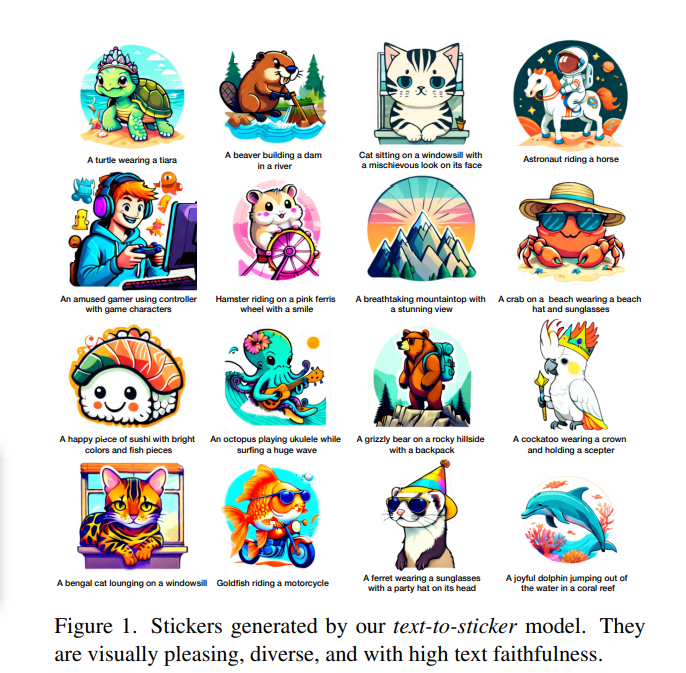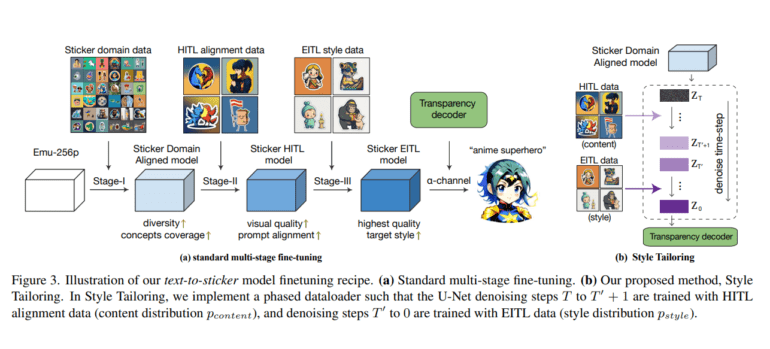TL;DR:
- Meta AI introduces Style Tailoring for fine-tuning Latent Diffusion Models (LDMs) in text-to-sticker generation.
- The method enhances visual quality, prompt alignment, and scene diversity in sticker image generation.
- Style Tailoring employs a multi-stage finetuning approach with domain alignment, human-in-the-loop, and expert-in-the-loop alignment stages.
- It achieves a remarkable balance between prompt alignment and style conformity, improving visual quality by 14%, prompt alignment by 16.2%, and scene diversity by 15.3%.
- The approach showcases generalizability across different graphic styles and outperforms baseline models.
- Despite its success, limitations include the challenge of maintaining balance and a focus on stickers, leaving room for exploration in other domains.
Main AI News:
In the ever-evolving landscape of AI-powered image generation, Meta AI’s GenAI researchers have introduced a game-changing innovation known as Style Tailoring. This cutting-edge method takes center stage in the fine-tuning of Latent Diffusion Models (LDMs) for sticker image generation, promising a significant boost in visual quality, prompt alignment, and scene diversity. The implications of this advancement are nothing short of revolutionary, and it all begins with a deep dive into the world of Style Tailoring.
The Quest for Visual Excellence
For years, researchers have been pushing the boundaries of text-to-image generation, with a particular focus on LDMs. These models have shown remarkable prowess in transforming natural language descriptions into high-quality visuals. However, one persistent challenge has been the delicate balancing act between prompt alignment and style coherence during the fine-tuning process.
Enter Style Tailoring
Style Tailoring, a brainchild of Meta AI, is the answer to this conundrum. It represents a paradigm shift in the world of sticker image generation, offering an innovative approach to fast alignment, visual diversity, and technical uniformity—all in the pursuit of crafting visually stunning stickers.
The Methodology Unveiled
At its core, Style Tailoring is a multi-stage finetuning process that meticulously refines the art of text-to-sticker generation. It encompasses three key stages:
- Domain Alignment: Weakly supervised sticker-like images are harnessed to align the model with the specific domain, setting the stage for further enhancements.
- Human-in-the-Loop Alignment: To improve prompt alignment, the model seeks input from human annotators, ensuring that the generated stickers align seamlessly with the given text.
- Expert-in-the-Loop Alignment: Expert input is leveraged to enhance the style of the generated stickers, resulting in an impeccable fusion of content and aesthetics.
- Achieving Balance and Excellence
The true marvel of Style Tailoring lies in its ability to strike a harmonious balance between prompt alignment and style conformity. This equilibrium is the key to its success, as it ensures that the generated stickers are not only visually captivating but also faithful to the provided text. The method’s effectiveness is underlined by impressive statistics, with visual quality improving by 14%, prompt alignment by 16.2%, and scene diversity by 15.3%.
Unmatched Generalization and Validation
Style Tailoring isn’t confined to a narrow niche. It exhibits remarkable generalizability across different graphic styles, making it a versatile tool for various applications. Rigorous evaluation, including human assessments and advanced metrics like Fréchet DINO Distance and LPIPS, validates its prowess in style alignment and scene diversity. Comparative studies with baseline models leave no room for doubt—Style Tailoring reigns supreme.
Room for Growth
As with any pioneering innovation, Style Tailoring acknowledges its limitations. While it addresses prompt alignment and style coherence admirably, the delicate balance remains a formidable challenge. The method’s focus on stickers also leaves room for exploration in other domains, calling for further research into its scalability, comprehensive comparisons, dataset expansion, and ethical considerations.

Source: Marktechpost Media Inc.
Conclusion:
Meta AI’s Style Tailoring is a game-changer in the world of text-to-sticker generation. Its ability to elevate visual quality, prompt alignment, and scene diversity sets a new standard in the field. With a promising future ahead, this innovation invites the scientific community to explore its potential in broader applications and embark on a quest for excellence in text-to-image generation.

